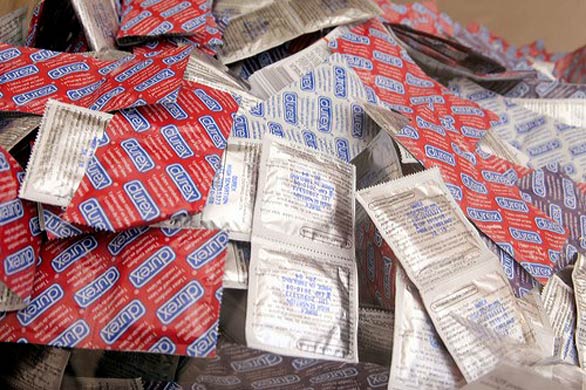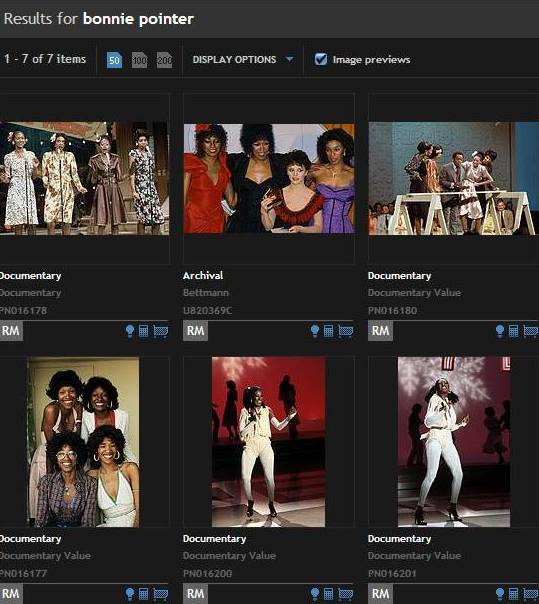Entries by Michael Atkins (1064)
Paris Museum Illustrates that Counterfeiting Affects Everyone

No laughing matter: counterfeit condoms at the Musée de la Contrefaçon
Photo credit: Yves Forestier / Getty Images
I’m all for combining tourism and trademarks. Next time I’m in Paris, I’m heading straight for the Musée de la Contrefaçon — the Museum of Counterfeiting. I just came across LA Times’ nice feature on the attraction, which the paper describes as a “postage stamp-sized palace” in the 16th arrondissement that is sort of a Noah’s Ark of French fashion: “two Lacoste crocodile shirts, two Hermès scarves, double doses of Birkins, hobos and clutches.” Of course, one’s real and one’s fake.
“The side-by-side comparisons are instructive, making such subtleties more readily apparent. But the museum’s most startling lessons unfold when the status goods that glow from the exhibits nearest the entrance give way to the stuff of everyday life. It’s here that the museum makes its strongest case for why consumers should care about counterfeiting.
“Exhibits are stocked with faux foodstuffs (including Tabasco, powdered milk, Laughing Cow cheese, Coca-Cola, Perrier and vermouth), tools (Swiss Army knives, Stanley tape measures), toys (poor quality ‘Babie’ dolls stand elbow to elbow with Barbies), car parts (oil filters, body panels, brake pads, ball bearings) and home appliances (pressure cookers) and, most frighteningly, health and beauty products such as condoms, pregnancy tests and Viagra — the only visible difference between the real and the fake being the shade of blue on the box.”
The article quotes the museum (and anti-counterfeiting trade group) president Marc-Antoine Jamet as saying people think of luxury goods when they think of counterfeiting. But they should be thinking about counterfeit medicine and airplane parts.
“It’s hard to be seen as a victim when you are talking about luxury goods,” he says. “But when you say [that] the people who make the fake perfumes and cosmetics also make fake medicine or products to clean your house, they listen to you more.”
Western District Finds No Likelihood of Confusion between HELIX Trademarks

In December 2007, Seattle’s RealNetworks, Inc., filed suit in the Western District against QSA Toolworks, LLC, seeking a declaration that its HELIX and HELIX and Design trademarks used in connection with digital media software do not infringe QSA Toolworks’ HELIX marks used in connection with relational database technology.
The parties cross-moved for summary judgment. A central issue was whether the parties’ products sold under their marks was similar. On Aug. 14, Judge Marsha Pechman clarified that the appropriate Sleekcraft factor is whether the products are “related” or “complementary,” which she found the parties’ offerings are not.
“The parties spend a good deal of time arguing whether their products perform ‘similar’ or ‘identical’ functions. RN argues that the ‘streaming media’ functions of its Helix software are entirely distinct from the ‘relational database management’ functions of QSA’s Helix applications; QSA argues that its product is used in streaming media configurations, that its Helix products have expanded beyond relational database management, and that RN’s Helix products have expanded beyond simple streaming media uses.
“But the Sleekcraft opinion does not refer to ‘identical’ or even ‘similar’ uses. The Sleekcraft court addressed this concern to whether the products are ‘related’ or ‘complementary,’ observing that ‘[f]or related goods, the danger presented is that the public will mistakenly assume there is an association between the producers of the related goods, though no such association exists … Although these product lines are non-competing, they are extremely close in use and function.’ The Court finds the Ninth Circuit’s ruling in M2 Software, Inc.v. Madacy Entertainment, 421 F.3d 1073 (C.A.9 (Cal.), 2005) instructive. In a trademark case where the litigants both distributed identical products (music and CDs) under the same name, the court found that ‘[t]herefore this [proximity] factor weighs in M2 Software’s favor, but only slightly because the genres of the music CDs are very significantly different.’ If the Ninth Circuit was willing to find only a ‘slight’ proximity factor between two manufacturers of a generically-identical product (CDs, downloadable music), this Court has little difficulty finding in RN’s favor on this factor.
“When fundamental functionality is distinct, the case supports a finding of ‘no confusion.’ QSA’s Helix software is used for creating applications which manage and modify information in relational databases, such as custom databases for tracking appointments and billing. In contrast, RN Helix products are utilized for the delivery of streaming media (audio and video), for media encoding and decoding in a variety of formats and ‘for the related efficient management of content delivery and network bandwidth for streaming over the Internet.’”
This led the court to grant RealNetworks’ motion for summary judgment in favor of a finding of no likelihood of confusion.
“With the exception of the “similarity of marks” factor (which is a ‘no decision,’ as opposed to a finding in QSA’s favor), the Court finds as a matter of law that the Sleekcraft factors overwhelming favor Plaintiff’s position of ‘no likelihood of confusion.’ On this basis, Plaintiff is entitled to a finding on summary judgment that there is no likelihood of confusion between its use of the Helix mark and that of QSA.”
The case cite is RealNetworks, Inc. v. QSA Toolworks, LLC, 2009 WL 2512407, No. 07-1959 (Aug. 14, 2009) (Pechman, J.).
Plaintiffs File Right of Publicity Class Action Suit Against Corbis

Corbis Web site with licensable images of plaintiff Bonnie Pointer
On Aug. 5, plaintiffs Anna Maria Alberghetti, Bonnie Pointer, and Judy Tenuta filed a class action lawsuit in the Central District of California against Seattle-based Corbis Corporation for allegedly making their images available for commercial purposes without their consent. The celebrity performers allege the image-licensing company violated their common law and statutory rights of publicity in doing so.
Plaintiffs define the putative class in pertinent part as: “All California residents whose names, images, or likenesses have been exploited by Corbis, without their permission, during the applicable statute of limitations time period through Corbis’ sale of purported licenses to use said names, images, or likenesses to consumers via that Company’s websites, including www.corbis.com, www.corbismotion.com, or www.corbisoutline.com. Also included in the Class are all non-residents of California who are United States citizens and whose names, images, or likenesses have been exploited by Corbis in the same manner as described in the preceding sentence, but only to the extent that such exploitation occurred through sales of purported licenses to California residents.”
Corbis has not yet answered.
The case cite is Alberghetti v. Corbis Corporation, No. 09-5735 (C.D. Calif.).
Ninth Circuit Finds No Likelihood of Confusion Between Competing "O" Marks
 No likelihood of confusion:
No likelihood of confusion:
O’Neal’s (left) and One Industries’ motocross logos
The Ninth Circuit decided a new likelihood of confusion case yesterday, One Industries, LLC v. Jim O’Neal Distributing, Inc. The case involves competing “O” logos used in connection with motocross equipment and apparel. The Southern District of California dismissed Jim O’Neal’s infringement claim on summary judgment, finding the differences in the parties’ logos precluded the likelihood of confusion.
The Ninth Circuit affirmed. After some interesting priority analysis on tacking, the court found that under the Sleekcraft factors, consumer confusion between the two marks was not likely.
“[Jim O’Neal’s] Rounded O’ mark is ‘fanciful,’ entitling it to strong protection. By itself, the mark neither describes nor ‘conveys an impression of a good.’ The Rounded O’ mark has ‘no intrinsic connection to the product with which the mark is used [i.e. a motocross helmet]’ and is a ‘wholly made up term[ ].’ The record, however, contains several examples of similar O marks used by different companies, including Oakley, OGIO, and Alloy MX. Such use of other ‘O’ symbols weakens the Rounded O’ mark. Based upon these offsetting considerations, we agree with the district court’s apparent view that the first Sleekcraft factor, at best, weighs slightly in favor of finding confusion.
“Although O’Neal and One Industries are direct competitors, we are persuaded that the marks do not look alike, that O’Neal has not produced evidence of actual confusion, and that no reasonable jury could infer that One Industries deliberately appropriated the goodwill associated with the O’ mark. The O’ mark, though conceptually strong, is weakened by the presence of other, similar marks. In the absence of evidence of actual confusion or intent to deceive, we decline to grant O’Neal a virtual monopoly on the use of the letter ‘O’ on motorcycle helmets. The mere fact that the two companies are direct competitors and happen to use the same letter on their products is not sufficient to show infringement. Accordingly, we conclude that there is no likelihood of confusion in this case, and that the district court properly granted summary judgment to One Industries.”
Additional blog coverage on the decision here and here.
The case cite is One Industries, LLC v. Jim O’Neal Distributing, Inc., __ F.3d __, 2009 WL 2581864, No. 08-55316 (9th Cir. Aug. 24, 2009).
Counterfeiting in Seattle: Need a Logo on that Kate Spade Purse?
The Seattle PI today ran a story about counterfeiting in Seattle. It said local police and federal agents last year served search warrants on 10 homes and businesses in one case and seized $242,000 and 7,873 alleged fakes from seven suspects. Not a bad haul.
I particularly like this account of undercover sleuthing: “Describing an undercover operation at a store owned by a man who later saw $180,000 seized, the detective said investigators found that most of the bags for sale there did not have tags sewn on. But, he alleged in court documents, the proprietor offered to add the tags when undercover officers moved to make a purchase.
”’(An undercover officer) asked the worker if the handbag on the wall was a ‘Kate Spade,” the detective said in court documents. ‘The worker stated that the handbag was in fact a ‘Kate Spade’ and that he could sell it to her. However, he needed to sew on a ‘Kate Spade’ logo for her.’”